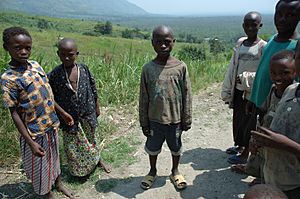Hutu facts for kids
| Regions with significant populations | |
|---|---|
| 11.1–12 million (84%–90% of the total population) | |
| 10.4 million (85% of the total population) | |
| 2 million (2% of the total population) | |
| Languages | |
| Kinyarwanda, Kirundi, French, English, Dutch (historically) | |
| Religion | |
| Mainly Christianity, minority Islam | |
| Related ethnic groups | |
| Tutsi, Twa, other Rwanda-Rundi speakers, and Bantu peoples | |
The Hutu, also known as the Abahutu, are an ethnic group from the African Great Lakes region. This area is in Africa. Most Hutu people live in Rwanda, Burundi, and the eastern Democratic Republic of the Congo. They are one of the main groups there, along with the Tutsi and the Great Lakes Twa.
Contents
Who are the Hutu?
The Hutu are the largest of the three main groups in Burundi and Rwanda. Before 2017, it was reported that about 84% of Rwandans and 85% of Burundians were Hutu. The Tutsi were the second largest group.
The Twa people are a smaller group. They share the same language and culture with the Hutu and Tutsi. However, Twa people are generally shorter in height.
Where did the Hutu come from?
Many people believe the Hutu first moved to the Great Lakes region from Central Africa. This happened during a big movement of people called the Bantu expansion.
There are different ideas about how the Hutu and Tutsi became distinct groups. The Tutsi were often herders who owned cattle. They are thought to have gained control over the Hutu and Twa, who were mainly farmers. Over time, the groups mixed through marriage. They also started to share the same culture and language.
Some people think the Hutu and Tutsi are related but developed differences over time. These differences might have grown because of European influence. Or, they might have happened naturally. For example, those who owned cattle became known as Tutsi. Those who did not own cattle became known as Hutu.
During the time of Belgian rule, people were often labeled as Tutsi or Hutu. This was based on things like how many cattle they owned, their physical looks, and church records. Today, the government of Rwanda no longer uses these labels.
Language of the Hutu
Hutu people speak Rwanda-Rundi as their main language. This language belongs to the Bantu family. It is part of the larger Niger–Congo language group.
Rwanda-Rundi has two main forms: Kinyarwanda and Kirundi. Kinyarwanda is an official language of Rwanda. Kirundi is an official language of Burundi. Both the Tutsi and Twa people also speak these languages.
Some Hutu people also speak French. French is another official language in Rwanda and Burundi.
History after Colonial Rule
The Belgian-supported Tutsi monarchy in Rwanda ended in 1959. The king, Kigeli V, was sent away. In Burundi, the Tutsi, who were a smaller group, kept control of the government and military. But in Rwanda, power shifted to the Hutu majority.
This change in Rwanda led to a "Social Revolution." There was violence by Hutu against Tutsi people. Many Tutsi were killed, and thousands fled to nearby countries. These countries included Burundi and Uganda.
In Burundi, there was a terrible event in 1972. Many Hutu people were killed. It is estimated that about 100,000 Hutus died. In 1993, Burundi's first democratically elected president, Melchior Ndadaye, was Hutu. He was believed to have been killed by Tutsi officers. This led to more violence between Hutu political groups and the Tutsi military. About 500,000 Burundians died during this time. The United Nations called these events a genocide.
While Tutsi people remained in control of Burundi, the conflict also led to a terrible genocide in Rwanda. A Tutsi rebel group, the Rwandan Patriotic Front, entered Rwanda from Uganda. This started a civil war against Rwanda's Hutu government in 1990. A peace agreement was signed, but the violence started again.
This led to the Rwandan genocide in 1994. During this time, Hutu extremists killed about 800,000 Rwandans. Most of those killed were Tutsi. About 30% of the Twa pygmy population in Rwanda were also killed. At the same time, the Rwandan Patriotic Front took control of Rwanda. They are still the ruling party today. Burundi is also now governed by a former rebel group, the Hutu CNDD–FDD.
By 2006, the violence between the Hutu and Tutsi had mostly stopped. However, the situation in both Rwanda and Burundi was still sensitive. Many Rwandans were still living outside their home country.
Images for kids
See also
 In Spanish: Hutu para niños
In Spanish: Hutu para niños


